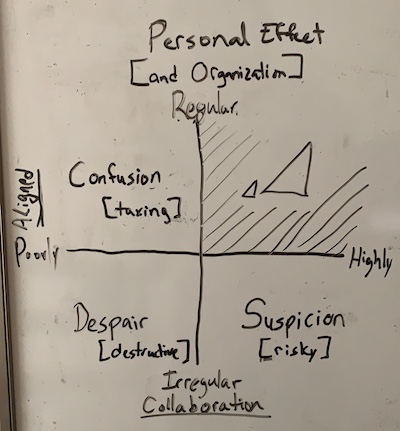Article
Align and Collaborate to Avoid
3 Leadership Pitfalls:
Suspicion, Confusion and Despair
Leaders serve to help teams align and collaborate. When managers and coaches fail to create alignment or facilitate collaboration their teams and teammates will fall into the traps of suspicion, confusion and despair.

The pitfall of Suspicion
Suppose you have a highly motivated individual in your team that puts in great effort on work that perfectly aligns with your business goals. What happens if you don't regularly collaborate with that individual? Suspicion arises in that person's mind. Interactions that are only one-way requests for updates won't convince your teammates that you want them to succeed. They’ll wonder if they’re doing the work that matters. They may soon suspect that you're playing on another team, or that they're being played.
Similarly, what happens when you don't recognize or find ways to reward their efforts? They begin to think that what you say is important isn't actually important. For a short time the most motivated individual will continue despite their doubts, because they're convinced the alignment is there. But after a while, they'll start contributing their efforts elsewhere - on other projects, or even worse, you'll risk losing them to another team or company.
Helping your team become highly-aligned to the mission and vision isn't enough. You need shared action, regular collaboration, to create a team atmosphere that's free from suspicion.
The pitfall of Confusion
Now suppose you're on the opposite side of this spectrum - you're meeting with your colleague daily to collaborate on work. What happens if you haven't explained what the work is going to accomplish and therefore haven't aligned this person to a shared vision? Confusion ensues in all but the most straightforward of assignments. If your collaborations consist of constantly reworking their contributions without clearly communicating from their perspective on why things need to be different, they'll become confused. They'll begin over-correcting or under-correcting in unexpected ways.
Similarly, what happens if they're working on things that don't align with your team's vision and mission and you're not saying anything about it? This colleague will become confused in thinking it does align, and will become incredibly lost if you pull the plug on their project in the 11th hour. Their actions throughout that time will have created confusion among the rest of your team, and your sudden course correcting will become a tale of warning that will make others worry about their own alignment even when they shouldn't.
Helping your team by doing the work with them isn't enough. You need shared vision, clear alignment, to create an atmosphere free from confusion.
The pitfall of Despair
Now let's shift to the lower-left quadrant, where your highly-capable teammate is both confused by the lack of shared vision and is suspicious of your intentions since they can't identify any collaboration from you. What happens if you fail to communicate clearly with them and avoid spending time collaborating with them on their work? They'll fall into despair. If you focus elsewhere and fail to help them, their story will become a cautionary tale to others that anyone can be left behind. If they, through some great fortitude, manage to stay in the team but remain in a poisonous despairing disposition - you can expect the morale of everyone will be impacted, and as a leader - you are to blame.
When members of your team fall into despair, you'll need to double your efforts to align and collaborate with them until they are out of the rut and in a better place.
Align, Collaborate, Succeed
Great teams are made up of individuals that have aligned their visions into their own North-Star. This beacon guides their activities even when short absences in collaboration occur, and they regularly collaborate to clarify and re-align to this North-Star.
Great leaders identify misalignment in all their interactions but can most effectively do this in one-on-one conversations. And when they find a teammate needs more collaboration, they're willing to prime action and facilitate activities. Great leaders help the individuals in their teams avoid confusion, suspicion and despair.
When leadership serves the team, great teams can align, collaborate and succeed.
- Align to avoid confusion.
- Collaborate to avoid suspicion.
- Succeed without despair.